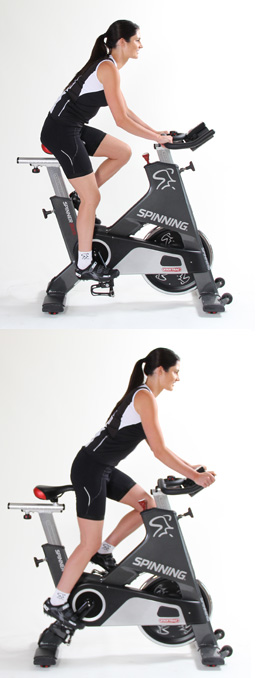
Jumps on a Hill
Posted by Spinning® on Apr 18th 2018
Michelle Colvin, International Spinning® Master Instructor (UK) Jumps on a Hill mimics three “real road” riding techniques: There will be times, however, when you need to stand:
There will be times, however, when you need to stand:
- To work your way around a hairpin or switchback curve up a mountain road.
- To burst or breakaway up a short, steep hill.
- To push yourself over the crest of a hill.
- To stretch your back
- To give your sitz bones a break
- To increase your cadence on a long climb
- To burst up a short, steep hill
- To work your way around a hairpin or switchback curve up a mountain road
- To push yourself over the crest of a hill
 There will be times, however, when you need to stand:
There will be times, however, when you need to stand:- When the grade of the hill increases
- When certain muscles fatigue from climbing in the saddle
- If the climb is short
- If an increase in power is needed to crest the hill or drop a fellow rider
- Keep your body weight over the cranks to maximize power through the pedal stroke.
- Keep the shoulders and the torso open to allow for maximum breathing capacity.
- Bouncing on the pedals is not advisable but there will be shifting from side to side as each leg powers the pedals during the down stroke.
- Breathing depth and rate will increase.
- Work on maintaining a rhythm with the focus on forced expiration and relax on the inspiration.
- A bend in a road with a very acute inner angle
- Built when a road climbs up or down a steep slope
- Travel can cross the slope with moderate steepness
- Zigzag pattern
- Repeating hairpin turns allow for easier, safer ascents and descents
- In bicycle racing, climbs up mountain roads with many switchbacks are considered the most difficult, and are often featured in the Tour de France, Giro d’Italia, Tour de Suisse and the Vuelta a España
- Alpe d’Huez in the French Alps is famous for its 21 hairpin bends
- Italy’s Stelvio Pass with its 48 Spitzkehren is one of the most famous Eastern Alpine Mountain passes
- Smooth transitions between seated and standing movements
- Head aligned with the spine
- Shoulders down and relaxed
- Flexion in the elbows
- Secure hold on the handlebars, safely alternating between handpositions 2, 2.5 and 3, while leaving and returning to the saddle
- Pelvis over the center of the bike when out of the saddle
- Stable hips
- Sitting bones on the widest part of the saddle when in the saddle.
- Degree in bend of hips varies according to position (decreasedflexion out of the saddle and increased flexion while in the saddle)
- Knees symmetrically tracking with the cranks and flywheel
- Ball of the foot over the pedal spindle
- Heels aligned and tracking symmetrically
- Cadence 60-80 RPM
